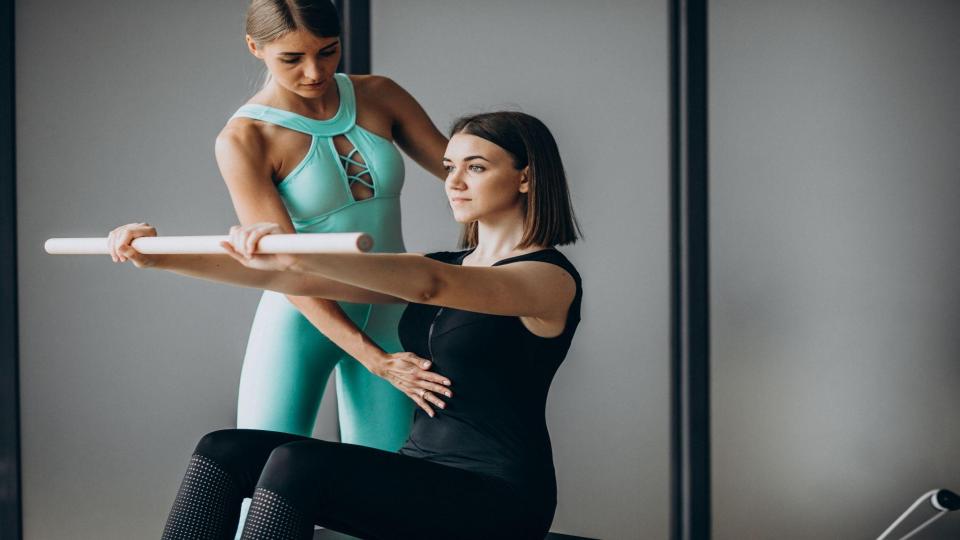Passive stretching vs. Active stretching: Benefits and When to Use Them

Published On : 27 Mar 2024
In the realm of fitness and wellness, stretching plays a pivotal role in maintaining flexibility, reducing muscle tension, and preventing injuries. However, not all stretches are created equal. There are primarily two types of stretching techniques: passive and active.
Each has its unique benefits and applications, and understanding the difference between the two can significantly enhance your workout routine and overall physical health.
What is Passive Stretching?
Passive Stretching, also known as Static Stretching, involves holding a stretch with the assistance of an external force, such as a partner, gravity, or a prop. This type of stretching is characterized by a relaxed and sustained stretch, typically held for 15 to 30 seconds.
Benefits of Passive Stretching
Improved Flexibility: Regular passive stretching can increase the length of your muscles and improve your overall flexibility.
Enhanced Relaxation: The gentle nature of passive Stretching helps relax both the mind and body, reducing stress and tension
Improved Range of Motion: Lengthening muscles and loosening joints can improve your range of motion, making everyday movements easier.
Injury Prevention: Enhanced flexibility and range of motion can reduce the risk of injuries during physical activities.
What is Active Stretching?
Active Stretching, or Dynamic Stretching, involves actively contracting one muscle group to stretch another without external assistance. This type of stretching is typically performed through controlled movements that mimic the activity or sport you're preparing for. Active Stretching is ideal for warming up before a workout or event.
Benefits of Active Stretching
Muscle Activation: Active Stretching helps activate the muscles you'll be using in your workout, improving performance.
Improved Blood Flow: The dynamic nature of active Stretching increases blood flow to the muscles, reducing the risk of cramps and injuries.
Enhanced Coordination: Active Stretching can improve coordination and agility by mimicking sport-specific movements.
Increased Body Awareness: Engaging in active stretches helps you become more aware of your body's movements and limitations.
When to Use Passive and Active Stretching
Passive Stretching is best utilized after a workout or during a cool-down session to aid in recovery and improve flexibility. It's an excellent way to gently lengthen muscles and enhance relaxation, providing both physical and mental stress relief.
The passive stretch test, where a partner or external force helps maintain the stretch, can be beneficial for identifying tight areas and monitoring flexibility progress. This type of Stretching is also helpful for individuals recovering from injuries or those looking to maintain or increase their range of motion without the added intensity of active movements.
Active Stretching on the other hand, Active Stretching is ideal for warming up before a workout or an athletic event. It prepares the muscles for activity by actively contracting them, which can help prevent injuries and improve range of motion and performance.
Incorporating active Stretching into your routine can also enhance strength and flexibility training by activating the muscles and increasing blood flow. This type of Stretching helps to prepare the body dynamically for the upcoming activity and is hence particularly beneficial for athletes or individuals engaging in high-intensity workouts.
Incorporating Stretching into Your Routine
Set a Schedule: Dedicate specific days and times for passive stretching to ensure consistency. Consider doing it after your workouts or before bed to help relax your muscles.
Warm Up with Active Stretching: Before any physical activity, use active stretching in your warm-up to prepare your muscles. This can help prevent injuries and improve your performance.
Cool Down with Passive Stretching: After your workout, incorporate passive stretching into your cool-down routine. This helps in muscle recovery and reduces soreness.
Stay Consistent: Regular stretching is key to seeing improvements in flexibility and range of motion. Stick to your routine for the best results.
Listen to Your Body: Never push a stretch to the point of pain. Stretching should feel like a gentle pull, not painful. If you feel any discomfort, ease up on the stretch.
By combining these two in your workout routine, you can get a well-rounded approach to flexibility and strength training.
Conclusion
Through this guide, you can Understand the differences between passive and active Stretching and how it is important for optimizing your fitness routine, as it can help in improving your flexibility, reducing the risk of injury, and enhancing your overall performance. Remember to listen to your body and adjust your stretching routine as needed to meet your individual needs and goals.
Ready to take your flexibility and strength training to the next level? Explore our range of fitness programs, passive stretch tests, and resources at L'ANATOMIE. Start your journey to an improved range of motion and well-being today!